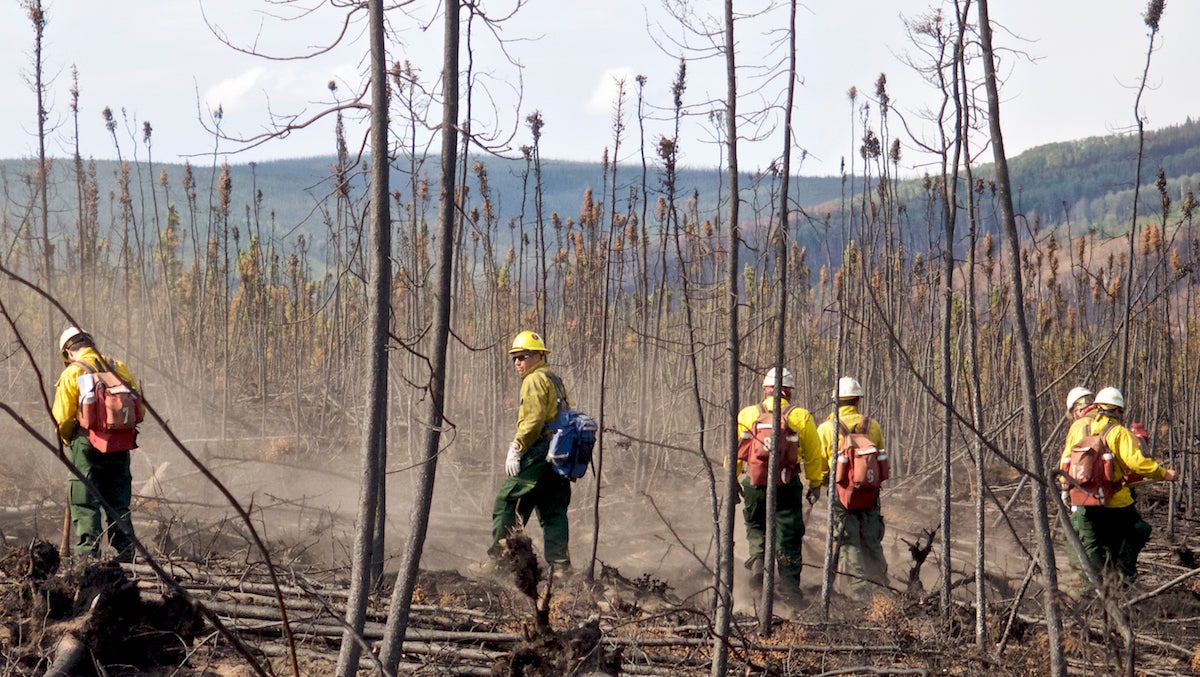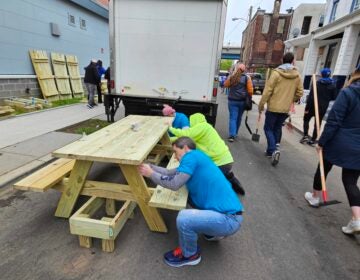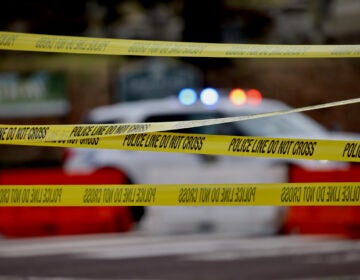Northwest Philly couple examines impact of climate change in new exhibit

Firefighters at Aggie Creek (Courtesy of Peter Handler)
A Northwest Philadelphia couple crisscrossing Alaska sounds like an episode of “The Amazing Race,” but instead of traveling for a million dollars, Peter Handler and Karen Singer were looking to spread awareness.
The married artists examined the impact of climate change, painting and photographing the sights for an exhibit currently on display at the U.S. Environmental Protection Agency’s regional headquarters at 1650 Arch Street. The exhibit is installed in the 54-foot long set of windows facing out toward 17th Street for passers-by to see.
“Alaska is a breathtaking beauty, but it’s also fragile. It’s warming faster than the other states,” said Fran Dubrowski, director of Honoring the Future, a nonprofit project using art to educate the public on climate change. Launched in 2013, the project was conceived while Handler and Dubrowski were designing her kitchen table. Dubrowski says she wanted something organic with a mountain as the base and that evolved into a conversation on the need for greater engagement with climate change.
“We realized art has a very important place in the education,” Dubrowski said. “Art is the antithesis of politics. It requires people to reflect and innovate.”
Dubrowski and Handler road tripped through the United States to see whether there was a substantial body of art focused on the global epidemic.
“We found beautiful, powerful, compelling examples all over the country of artists pouring their creativity and talent into showing the public what they had seen in the way of climate change,” Dubrowski said.
“We knew we had to get this public attention.”
Canary in a Coal Mine
Peter Handler, 68, was born in Brooklyn and moved to Germantown in the early 1980s. He studied political science in Maine and planned to go to law school and then get involved with politics to “change the world.”
“Then the 60s happened,” Handler said. While his classmates applied to law school and graduate school, he applied for conscientious objector status during the Vietnam War. His draft lottery number ended up being too high so he never served.
In the summer of 1969, Handler ran a jewelry shop in Maine for a week, helping out a friend, and using the money to go to Woodstock. But the craft hooked him, leading to art school and eventually furniture-making.
Handler’s passion for climate change ignited in the late 1980s as he read tomes of evidence of weather patterns shifting, causing an upcoming global warming.
“Isn’t that depressing?” Handler recalls people asking him. “No, it’s just information. But when you think about what’s happening to the world, yes, it is depressing.”
Handler read Al Gore’s “An Inconvenient Truth” during the summer of 2008, just as the recession hit.
“I stopped getting work,” Handler said. “But a friend of mine told me ‘at times when I have no work, I make the art I want to make.'”
So Handler began crafting a series titled “Canaries in a Coal Mine,” an allusion to caged canaries that miners would carry down into the tunnels to determine if dangerous gases had collected in the mine. The gases would kill the canaries before killing the miners, thus providing a warning to evacuate immediately.
Handler’s pieces consisted of a coral reef and golden toad, whose destructions indicate that climate change has already taken effect. He wanted his next piece to be about permafrost, permanently frozen soil or rock that has been thawing due to global warming.
“To do my next canary, I needed to go to Alaska,” Handler said.
Never stopped
Karen Singer, 61, was born in Wisconsin and moved to Philadelphia in the late 1970s. She earned her Bachelor of Arts at Pitzer College in Claremont, California and her Masters of Fine Arts at the University of Pennsylvania. She did independent work in printmaking at Ecole Des Beaux-Arts in Paris, and was awarded an apprenticeship at the Moravian Pottery and Tileworks in Doylestown.
Primarily working with ceramic tile, Singer has also dabbled in plaster relief sculpture, etching and carved wood.
“Most people draw and make things when they’re kids, but I never stopped,” Singer said. “It was a way I could express what I thought and felt.”
She met Handler years before they became a couple, when he moved into a studio in Manayunk near her friend’s studio. Both of their previous marriages had ended around the same time, so Singer says they ended up talking about their personal lives. Although they both had immense respect for each other’s artwork, something had changed in the dynamic.
“You might have met somebody years before, and depending on the circumstances, you might not have worked out as a couple,” Singer said. “But as you change in life, sometimes the circumstances change as well.”
The husband and wife team has collaborated on small projects such as the “Canaries in a Coal Mine series,” but whereas Singer felt like a subcontractor on those pieces, she felt like a partner on the Alaska voyage.
“It was an amazing opportunity,” Singer said. “The two of us could work together on something we care about.”
They talked with a student rabbi at their synagogue who had lived in Fairbanks, Alaska for 20 years, working as a biologist at the University of Alaska-Fairbanks. She connected them with scientists in Fairbanks and the networking began as more and more people associated with climate change united over the couple’s trip.
Financing through informal crowdsourcing among family and friends, Handler says about a month before the journey, a couple reached out to offer their home and more importantly, a car.
“There is a precondition to renting cars in Alaska—you have to stay on paved roads,” Handler said. “Well, if you’ve never been to Alaska, there aren’t many.”
The voyage
For two weeks in July of 2015, Handler and Singer explored The Last Frontier, witnessing a raging wildfire, part of over 5,000,000 acres which burned after the hottest Alaskan spring in 91 years of record-keeping. While Singer painted from an aerial view, Handler photographed ground level with firefighters standing in the smoldering ashes and thick smoke.
They also toured an underground research facility operated by the U.S. Army Corps of Engineers which is normally open only to research scientists and engineers. Excavated in the 1960s at an old gold mine near Fairbanks to study mining techniques, the “permafrost tunnel” exposed undisturbed frozen soil, bedrock, plant and animal fossils and bacteria accumulated over 40,000 years.
Both artists focused on how, as temperatures rise, thawing of the “permafrost” underlying most of the state destabilizes the ground with trees tilting and falling.
“As climate activists, if you want to save the world, you need to think in terms of what to savor,” Handler said. “We need to show the beauty to truly make the point of how devastating this upcoming destruction will be.”
Singer says that a lot of people’s response to the concept of climate change is hopelessness.
“They either can’t believe it or won’t believe it or they think it’s too late so they forget about it,” Singer said.
“I didn’t see any of that there. People were trying to learn as much as they can to figure out what to do. Even if you can’t know the outcome, all you can is do put your energy toward what you believe in. We believe in the power that art can have to open people’s hearts and see the world in a different way.”
Dubrowski has been thrilled with the exhibit so far and plans to extend the presentation to other cities.
“Climate change is one of the biggest challenges we face as a society today,” Dubrowski said. “Our responses will determine the future of our children and grandchildren. If we want to leave them a sustainable world, we need to address this.”
As part of Honoring the Future’s initiative to give students a voice on climate change, Singer has helped students from Mishkan Shalom Synagogue School in Philadelphia in a pilot workshop for creating a digital mosaic. Students make pieces of art that reflects what they want to say to the world about climate change and then write their artist statement underneath.
“I tease him (Peter) that you can save the world, but I’m just worried about saving Philadelphia,” Singer said.
Serving on the board of Women In Transition, an organization that deals with domestic violence issues, and remaining active with Germantown United CDC, Singer says that she is coming into her own in terms of leadership.
“I tend to do it on a person-to-person, more local level,” she said. “So going to Alaska made climate change personal for me.”
Handler hopes that the exhibit will convince skeptics to believe and mobilize believers to action.
“Aside from driving Priuses and using LED lights at home, we need to ultimately change policy,” Handler said.
A member of Citizens Climate Lobby, Handler works with fellow activists to get Congress to enact a fee on carbon.
“If we drop our national carbon footprint, we stand a chance at bringing this under control,” Handler said. “We’re not going to stop climate change, but we need to keep it to something we can live with.”
WHYY is your source for fact-based, in-depth journalism and information. As a nonprofit organization, we rely on financial support from readers like you. Please give today.




